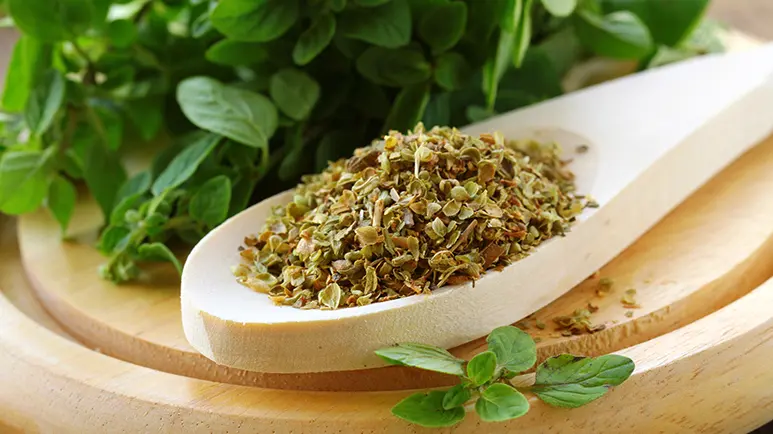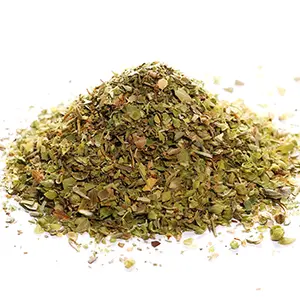Oregano: The Surprising Role This Kitchen Staple Plays in Pet Care
Commonly added to pizza and pasta sauces for its minty and earthy flavor and aroma, this herb can be lightly sprinkled over your pet's meals for an antioxidant boost. It can even be used as an ingredient in their favorite treats. Have you tried using it yet?

STORY AT-A-GLANCE
- Oregano has antioxidant, anti-inflammatory and antimicrobial properties, and if your pet is struggling with yeast, this herb is a welcome addition to their meals
- Terpenes, mainly thymol, carvacrol, p-cymene and γ-terpinene, are the primary beneficial components in oregano, and are responsible for its pungent aroma. Terpenes, particularly carvacrol and thymol, may have anti-inflammatory effects
- Many dogs suffer from infections due to yeast, a spore-like type of fungi that usually affects the skin and ears. Adding small amounts of natural antifungal foods like oregano to their diet can help moderate the level of yeast in your dog's body
- Aside from adding fresh or dried oregano to your pet's homemade meals and treats, you can use high-quality oregano essential oil (diluted) for its potent antibacterial and antiparasitic effects
- To ensure you're getting high-quality oregano, make sure to buy certified organic, spray-free varieties from your local farmers market. Better yet, try growing it in your backyard
Editor's Note: This article was originally published September 21, 2023.
Adding oregano to pasta or pizza sauce elevates the flavor of the dish, with its pungent aroma and earthy, slightly minty flavor. But did you know that sprinkling a small amount of this herb, dried or fresh, over your pet's meals or mixing it into treats can also impart profound benefits on their health? Here's what you should know when offering oregano to your pet.
What Is Oregano and What Can It Do for Your Pet?
There are many different species of oregano, but the most common is Oregano vulgare, or Mediterranean oregano. Also called Greek oregano,1 wild marjoram or Spanish thyme, it belongs to the Lamiaceae (mint) family and has been used for thousands of years to flavor food and help ease certain health conditions like skin sores and colds.2,3,4 Another variety is Lippia graveolens, or Mexican oregano — it's a member of the verbena plant family (Verbenaceae).5
A perennial herbaceous plant, Mediterranean oregano has small purple flowers and grows to about 1 to 2 feet tall. Just like the leaves, these blooms are edible, too. Mexican oregano, on the other hand, grows up to 3 to 9 feet high, with yellow or white flowers.6
Mediterranean oregano has a sharp pine-like and peppery flavor. It has an earthy base with lemon and menthol undertones. Mexican oregano, on the other hand, is grassy and reminiscent of anise, with lively citrus and lime flavors.7
The good news is both varieties are OK to share with pets, as long as they're given in moderate amounts. Oregano has antioxidant, anti-inflammatory and antimicrobial properties, and if your pet is struggling with yeast, this herb is a welcome addition to their meals.
Oregano Trivia

In Greek and Roman civilizations, Mediterranean oregano was associated with happiness. In fact, its name is derived from the Greek words "oros" and "ganos," which means "joy of the mountains," referring to its preference for growing at high altitudes.8
The Terpenes in Oregano Offer Antioxidant Effects
There's a lot of misinformation about healthy fruits, vegetables, nuts and seeds all over the internet, mostly because websites have labeled all risks (such as the risk of overconsumption causing gastrointestinal issues, or choking on too large of pieces or pits) as "toxicities." Not all of these are true yet they've managed to confuse millions of pet lovers, nonetheless.
In the case of oregano, many websites have warned of its potential to be "poisonous" to pets.9 On the contrary, this spice is not toxic at all, and as long as it is given in moderate quantities, there's no risk of causing any side effects. In fact, oregano offers disease-busting properties that may benefit your pet. For example, one study found oregano oil may have antimicrobial activity that may be beneficial for dogs suffering from ear infections (otitis externa). According to the study authors:10
"Oregano oil, thyme oil, carvacrol and thymol showed good in vitro bactericidal and fungicidal activity against 100 isolates from dogs with otitis externa, including some highly drug-resistant isolates. These essential oils and their main phenolic constituents have the potential to be further investigated in vivo for the treatment of canine otitis externa."
Terpenes, mainly thymol, carvacrol, p-cymene and γ-terpinene, are the primary beneficial components in oregano and are responsible for its pungent aroma.11 These terpenes, particularly carvacrol and thymol, may have anti-inflammatory effects. One study found terpenes from three species of Mexican oregano (Lippia graveolens, Lippia palmeri and Hedeoma patens) may help treat inflammatory conditions. The researchers noted:12
"The phenolic and terpene extracts from LG, LP and HP exhibited significant inhibitory effect on ROS and NO production and mitochondrial activity in LPS-induced inflammation in RAW 264.7 macrophage cells."
Moreover, a 2021 study investigated the potential effects of improving dog food's antioxidant load by adding extracts from different herbs including oregano, rosemary and cloves. The researchers found that adding "natural antioxidants in dog feed, in addition to promoting feed conservation, stimulate levels of systemic antioxidants and minimize the impacts caused by free radicals in the dogs' blood."13
Did You Know?

Of all herbs and spices, dried oregano ranks second place (after cloves) in terms of its Oxygen Radical Absorbance Capacity (ORAC) values — this is a test that determines the total antioxidant capacity of a food.14,15
Oregano May Help with Yeast Infections
Many dogs suffer from infections due to yeast, a spore-like type of fungi that usually affects the skin and ears. The most common type of yeast that affects canines is Malassezia pachydermatis (M. pachydermatis). If your dog has a chronic yeast infection, the most crucial strategy to control it is making significant changes to their diet. Not addressing diet is the biggest mistake pet parents make when it comes to losing the chronic yeast battle.
"Adding small amounts of natural antifungal foods like oregano to your pet's diet can help moderate the level of yeast in their body."
In one study using mice subjects infected with a type of yeast called Candida albicans, oregano oil was found to inhibit the fungi.16 A 2019 study also found that carvacrol and thymol may have in vitro activities against M. pachydermatis.17 Other foods that may also have antifungal effects for pets include fresh garlic, parsley and thyme.
However, remember that the first course of action is to remove all sources of starch from your pet's diet. Yeast uses sugar as a source of energy, and carbs break down into sugar. Some of the most popular pet foods are the worst offenders in terms of hidden sugar, so never assume because you're paying a lot for your pet food that it's healthier.
Adding fermented veggies to your dog's meals can also be very beneficial, along with raw, unfiltered apple cider vinegar and coconut oil, which contains caprylic acid that has anti-Malassezia properties.
Oregano May Also Help Manage Diabetes
Oregano also has antidiabetic effects, as it may help lower blood sugar levels. A 2019 study published in the Molecules journal looked at the potential of several herbs and spices in regulating processes related to diabetes and found that oregano may help increase serum insulin levels, helping treat insulin-deficient diabetes.18
A separate 2015 study that looked at the effects of oregano extract on diabetic-induced mice found the oil helped minimize diabetes incidence and protected the test subjects' insulin secretion. The researchers noted that "acting as an antioxidant, immunomodulator and in an anti-apoptotic manner, MOE [methanolic oregano extract] protected mice from diabetes development."19
A Delicious Pet Treat Recipe Featuring Oregano
Oregano can be sprinkled directly onto your pet's food or it can be infused into homemade treats, like pet-friendly coconut scones. Try making these healthy "cookies" for your pet — they're even helpful if your pet is dealing with allergies, as they provide immune system support against local allergens. Plus, they'll make your kitchen smell amazing!
Coconut Scones Recipe
Ingredients:
- 1 cup plain organic whey protein
- 6 Tbsp. coconut flour
- 1 tsp. fresh oregano
- 3 Tbsp. melted coconut oil
- 3 Tbsp. local organic honey
Procedure:
- Mix all the ingredients together in a bowl.
- Grease your hands well with coconut oil and press the dough flat onto a greased cookie sheet. Bake at 375 degrees F (190 degrees C) for 5 minutes.
- Once done, loosen the edges and flip onto a cooling rack. Cut into desired sizes once cooled. Store in the freezer or refrigerator and consume within one week. If stored in the freezer, treats can stay fresh for up to three months.
Note: Feel free to lick the bowl!
Top Oregano Producers Worldwide

China, India, Germany, Egypt, Kenya and Spain are the top global producers of the world's oregano supply. In 2021, the oregano market was valued at $10.63 billion, and experts predict it may reach up to $17.6 billion by 2029.20

Oregano Oil Can Be Useful for Pets, Too
Aside from adding fresh or dried oregano to your pet's meals and treats, you can use high-quality oregano essential oil for its potent antibacterial and antiparasitic effects. Try adding a few drops of this oil to pet-friendly shampoo to minimize bacterial growth in pets dealing with MRSA infections. Diluted oregano oil can also help soothe irritated gums, clear ear mites, ease itchy skin and balance your pet's gut flora.
Remember to always dilute oregano oil before using it in or on pets; mix 1 drop oregano oil with 10 drops carrier oil, such as calendula or coconut oil. If using it to get rid of ear mites, clean the ear by removing the gunk and debris before applying diluted oregano oil.
Is Oregano Sustainable?
Oregano is well-known for its hardiness, even when growing in arid conditions, and has a low water footprint. Compared to other mono-cropped plants, it ranks low on environmental impact. This herb can also be used as ground cover, which protects against erosion and helps retain moisture in the soil.21
Studies have also found that oregano can help reduce the methane emissions from farm animals, like cattle, and increase their milk production. In fact, agricultural researchers found that methane emissions decreased by as much as 40% and milk production increased by 4% when oregano was added to cattle feed.22
To ensure you're getting high-quality oregano, make sure to buy certified organic, spray-free varieties from your local farmers market. Better yet, try growing it in your backyard.
Sources and References
- 1,7 Spices Inc., Mexican Oregano vs. Oregano
- 2,8 Medical News Today, November 8, 2023
- 3,5,6 McCormick Science Institute, Oregano
- 4 Nutrition Today 45(3):p 129-138, May 2010
- 9 Wag!, Oregano Poisoning in Dogs
- 10 Veterinary Dermatology, Volume 30, Issue 6, December 2019, Pages 524-e159
- 11 Molecules. 2017 Jun; 22(6): 989
- 12 J Ethnopharmacol. 2016 Jul 1;187:302-12
- 13 Archives of Animal Nutrition, Volume 75, 2021 - Issue 5
- 14 Brain Health and Wellness, Table - ORAC (Antioxidant) Value of Spices and Herbs (Archived)
- 15 Scientific American, August 14, 2013
- 16 Mol Cell Biochem. 2001 Dec;228(1-2):111-7
- 17 J Mycol Med. 2019 Dec;29(4):375-377
- 18 Molecules. 2019 Nov; 24(22): 4030
- 19 Br J Nutr. 2015 Mar 14;113(5):770-82
- 20 FrutPlanet (Archived)
- 21 FoodPrint, Real Food Encyclopedia, Oregano and Marjoram
- 22 BC Farms and Food, May 24, 2022











